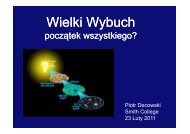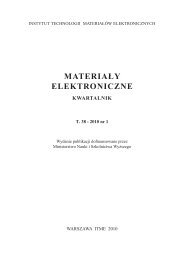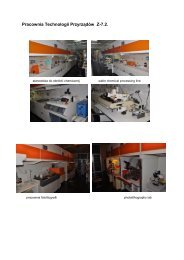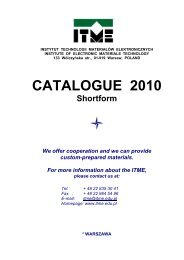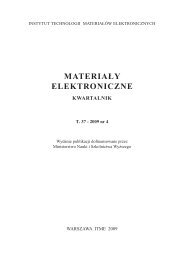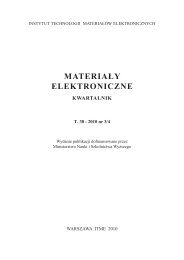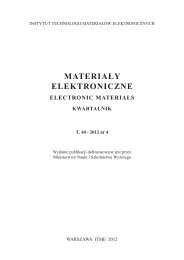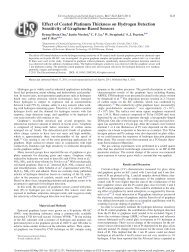Nr 1 - ITME
Nr 1 - ITME
Nr 1 - ITME
You also want an ePaper? Increase the reach of your titles
YUMPU automatically turns print PDFs into web optimized ePapers that Google loves.
SiC die-substrate connections for high temperature applications<br />
were cleaned in acetone before use. Two types of thick film pastes onto alumina<br />
substrates were applied : P-205 (Ag-Pd-Pt paste produced by <strong>ITME</strong>) and P-301 (Au<br />
paste produced by <strong>ITME</strong>).<br />
Fig.1. The scheme of investigated test sample.<br />
Rys. 1. Schemat struktury testowej.<br />
3. EXPERIMENTS AND RESULTS<br />
The condition for performing the experiments and results of adhesion measurements<br />
at room temperature are presented in Tab. 2.<br />
Table 2. The results of adhesion measurements for investigated bonding technologies.<br />
Tabela 2. Wyniki badań adhezji dla badanych materiałów i technik łączeniowych.<br />
Die bonding<br />
technology<br />
Process<br />
temp.<br />
[°C]<br />
Max operating<br />
temp.<br />
[°C]<br />
Shear strength<br />
[N/cm 2 ]<br />
Au88Ge12 400 330 N/A<br />
P-1011 150 350 150<br />
FO-3, FO-23 560 350 >200<br />
3M 9890 25 260 30<br />
Ag nano 300 400 160<br />
Among bonding materials for SiC die, hard solder of eutectic gold-germanium<br />
alloy with melting temperature of 356ºC was applied in our research. Gold-germanium<br />
performs with the thickness of 50 µm was placed between SiC die and substrate<br />
with Au thick film. To accomplish this process gold metallization on SiC die was<br />
deposited too. The joint was formed during soldering in temperature 400°C. The<br />
mechanical and physical properties of such formed solder connections will be taken<br />
into account in the next step of our researches.<br />
102




